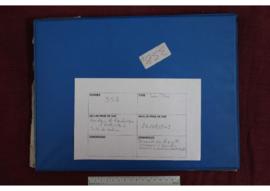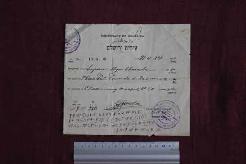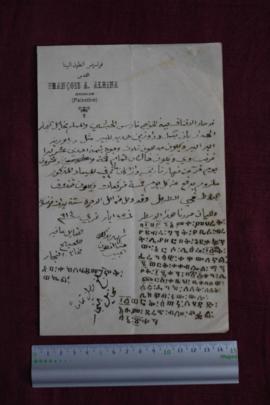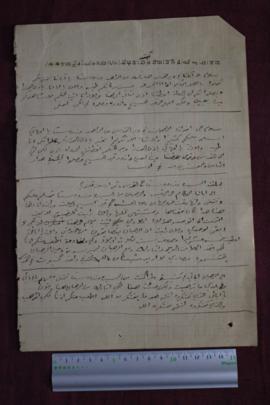Identity area
Reference code
Title
Date(s)
- 1896-01-01-1968-04-23 (Creation)
- 1896-01-01-2018 (Creation)
Level of description
Fonds
Extent and medium
Global extent: to be completed; 177 selected and described items
Context area
Name of creator
Administrative history
Until the middle of 20th century, the Ethiopian Orthodox community in Jerusalem was led by an abbot, appointed by the Ethiopian monarchy. He was in charge of the Ethiopian monasteries in Jerusalem and Jericho. In 1951, a new organization of the Ethiopian Orthodox Church was established and new dioceses were defined in Ethiopia and aboard. The diocese of Jerusalem, including all Ethiopian Orthodox communities in Holy Lands, was created with its headquarter in the old city of Jerusalem. Thus, the Ethiopian Orthodox community was not anymore led by an abbot but a bishop. The Jerusalem bishopric was later upgraded to Archbishopric from 1959.
Some Ethiopian Bishops:
- Filppos (1951-1966)
- Yosef (1966-1972)
- Matéwos (1972-1977)
- Matthias (1979-1982; 2009-2013)
- Selama (1982-1984)
- Gabriel (1998-2001)
- Kewistos (2002-2005)
The Archbishopric of Ethiopian Orthodox Church in Jerusalem organizes and supervises the religious activities of the Ethiopian Orthodox communities in Israel and in Jerusalem. It also manages the different properties that the Ethiopian Orthodox Church acquired in Israel and Jerusalem.
Archival history
It seems that the archives’ organisation changed several times during the last 50 years: therefore, today’s folders represent only the last state of many arrangements.
Some of the oldest documents show marks of fire incidence and conversation works. These are clues of the poor condition of these archives until the 1960s as stated in the 1966 report found in Addis Ababa.
Immediate source of acquisition or transfer
Content and structure area
Scope and content
The Ethiopian archbishop’s residence in the old city preserves a part of Ethiopian community’s archives. These archives are divided into two main sections: the current administrative archival office, which includes all types of administrative documents, and the manuscript section.
-
The Administrative section
In the current administrative archival office, there is an heterogeneous set of documents dated from the end of 19th century to present. There is no historical archives properly speaking. These archives are still used by the local administration for current affairs.
Among all the folders stored in that place, seven include documents created before 1950: folders n°6, 154, 356, 358, 359, 360 and a last one entitled in Amharic “yä-leyu leyu guday däräseññoč käzih yegäññalu” including different types of documents unclassified. In addition to these folders, a book written in 1903-1904 (manuscript in Amharic) was recorded as “folder” n°172 and a report written in 1925 as “folder” 216.
Documents dated before to 1950 found in the archives (ca. 160 documents) are administrative and financial documents, such as payment receipts, cheques, bank documents, financial reports, letters and correspondence including daily issues of the community, etc. These documents are written in Arabic, English, French, German languages. Amharic marginalia are often added to documents in order to give a clue to the topic of the document. Very few documents are fully written in Amharic. 55 documents are written in Arabic. -
The manuscripts section
The manuscripts section carefully preserves numerous parchment and paper manuscripts written in Ethiopian languages (Geez and Amharic). The collection represents more than 760 manuscripts. The oldest one dates back to the 15th century.
Through this collection, one could study the daily life of the Ethiopian religious community established in Jerusalem, and get information to understand all their problems and opportunities, such as housing, supplies, access to public services, administration or worship. Receipts and payment document are witnesses of Ethiopian involvement in local life.
Appraisal, destruction and scheduling
Accruals
The collection is still increasing.
System of arrangement
Conditions of access and use area
Conditions governing access
Subject to the authorization of Ethiopian Archbishop Residence in Jerusalem.
Conditions governing reproduction
Language of material
Script of material
Language and script notes
Physical characteristics and technical requirements
Finding aids
Two catalogues are available for the manuscript section, but they provide incomplete information.
Allied materials area
Existence and location of originals
Existence and location of copies
Related units of description
Publication note
Pedersen, Kirsten. The History of the Ethiopian Community in the Holy Land from the Time of Emperor Tewodros II till 1974. Jerusalem: The Ecumenical Institute for Theological Research, 1983.
Publication note
Pedersen, Kirsten. “The Historiography of the Ethiopian monastery in Jerusalem”, Ethiopian Studies, Proceedings of the Sixth International Conference of Ethiopian Studies, edited by G. Goldenberg and B. Podolsky, 419-426. Rotterdam: Balkema, 1986.
Publication note
Ancel, Stéphane and Lemire, Vincent, "New Sources on the Ethiopian Christian Community in Jerusalem, 1840–1940", Jerusalem Quarterly, vol. 71, 2017, pp. 106-119.
Publication note
Notes area
Alternative identifier(s)
Access points
Subject access points
Place access points
Name access points
Genre access points
Description control area
Description identifier
Institution identifier
Rules and/or conventions used
ISAD(G), Second Edition, Ottawa 2000.
Status
Level of detail
Dates of creation revision deletion
Catalogue prepared on January 2018
Language(s)
Script(s)
Sources
Archivist's note
Inventory of a range of items from the Archives of the Ethiopian Archbishop Residence in Jerusalem, (1896-Present), held by the Ethiopian Archbishop Residence in Jerusalem, made by Stéphane Ancel, 2018.










